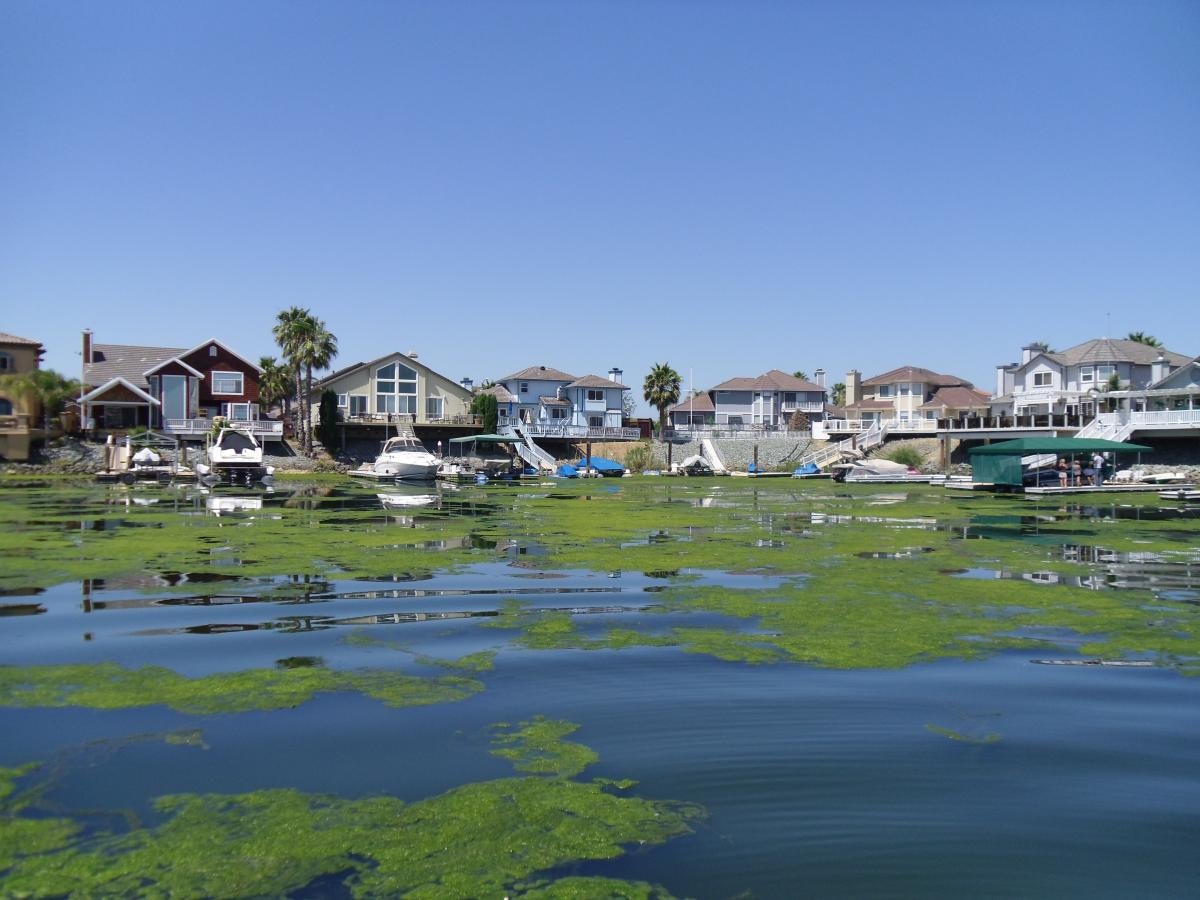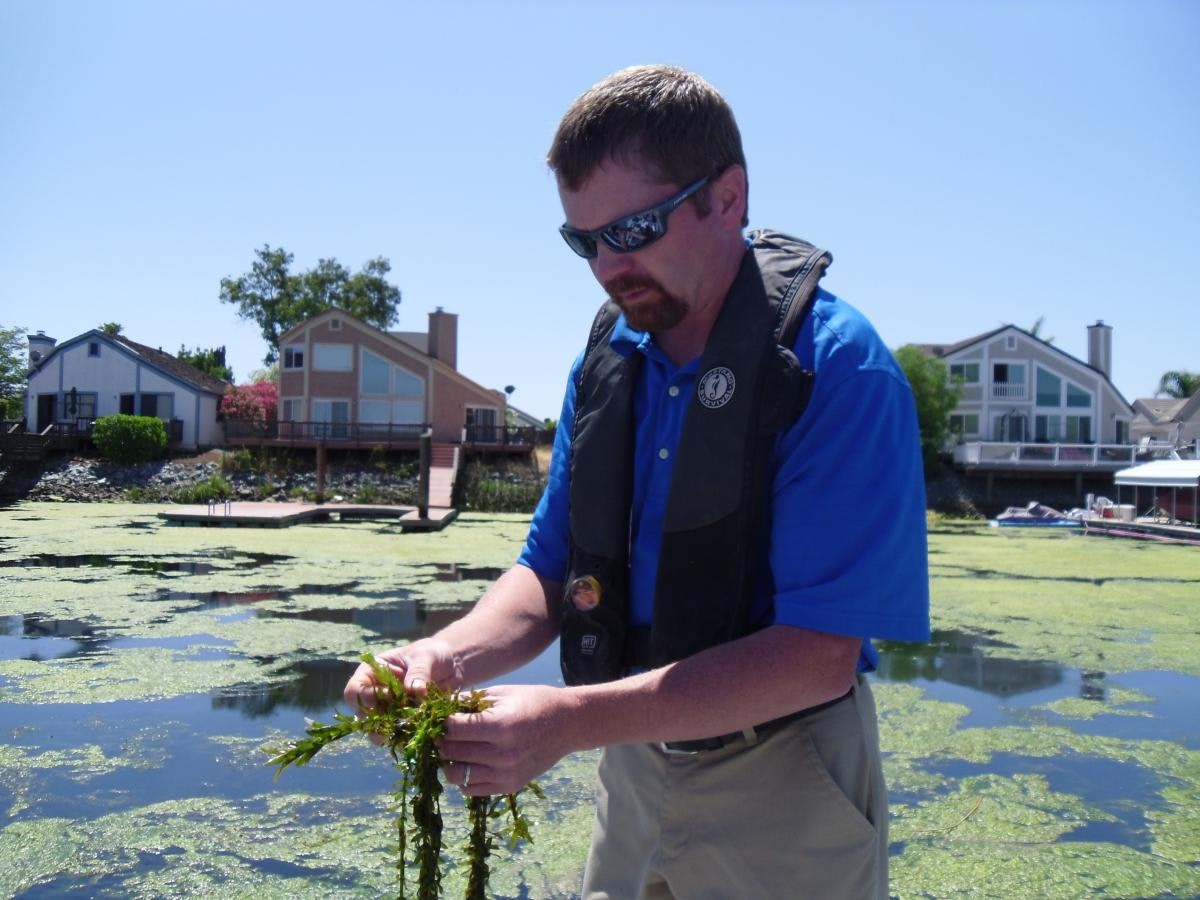Delta Water Weeds

Due to its location on the Delta, invasive aquatic weeds are prevalent throughout Discovery Bay. The most common types of invasive species are Egeria Densa, Water Hyacinth and the Curly Leaf Pond Weed.
These weeds have tendencies to grow rapidly and are known to block bays and waterways, making boating almost but impossible in some instances.
The state of California Department of Boating and Waterways (DBW) has taken an aggressive stand against these weeds and have chemically treated Discovery Bay to manage (not eradicate) the variety of weed species in the area.
Whether you are a deep-water property owner or just love to sightsee, fish or play on the Delta waterways, the following information is helpful in understanding the water weed issues.
Water Hyacinth
The Water Hyacinth, with its colorful flowers and big green leaves, is anything but desirable in Delta waterways. Left to its own desires it will totally clog bays, waterways, channels and marinas. When broken up by boaters, the clumps move on with the flows and tides to establish new devastations.
Egeria Densa
The Egeria Densa is anything but attractive. It is a shallow-water submerged aquatic plant that requires both warmth and light to thrive but winters well to reappear in the spring stronger and better than last season. It roots to rocks and silt only to a depth of eight to ten feet with its round pad of foliage floating barely to the surface. Given time and no treatment it will clog bays and waterways. Removal by hand results in tiny pieces being broken off.
What both of these weeds have in common is that they severely deplete the oxygen levels in the water and are almost impossible to totally eradicate once they are established.
Methods of Control and Eradication

This segment from the Boating and Waterways website may help you understand what is required to deal with these pests:
Department of Boating and Waterways’ Aquatic Pest Control Program
- State legislation in 1982, designated the Department of Boating and Waterways (DBW) as the lead agency for controlling Water Hyacinth in the Sacramento-San Joaquin Delta, its tributaries and the Suisun Marsh.
- The Egeria Densa program was added in 1997; however, treatment did not begin until 2001 due to litigation that prevented all DBW weed treatment during the 2000 season.
- DBW currently spends approximately $7 million yearly on these efforts.
- These weeds have a negative impact on the Delta ecosystem. They displace native plants, block light needed for photosynthesis, reduce the amount of dissolved oxygen in the water, and deposit silt and organic matter at several times the normal rate.
- These weeds also have a significant impact on recreation and commercial activity in the Delta. They form dense mats of vegetation that create a safety hazard for boaters, obstructing navigation channels, marinas and irrigation systems.
- Due to the significant infestation, DBW operates a “control” program as opposed to an “eradication” program. It is not expected that Water Hyacinth and Egeria Densa will ever be eradicated from the Delta area.
- The only successful control measure is herbicide application. Both plant species’ have no known natural enemies in the Delta environment. However, DBW is studying the use of water hyacinth weevils as a biological control in Seven-Mile Slough.
- DBW’s Aquatic Weed Control Program is permitted by the National Oceanic and Atmospheric Administration Fisheries, the U.S. Fish and Wildlife Service, and the Regional Water Resources Control Board.
- DBW operates an extensive water quality monitoring program that shows that the control program meets water quality standards for herbicide use.
- Since litigation in 1999, treatment in most areas of the Delta has been limited to July 1 through October 15 due to regulatory agency concerns about endangered species. This restriction hampers program success as the herbicides must be applied during the early growth season to be most effective.
- Annual hyper spectral aerial survey is used to monitor changes in infestations over time.
Water Hyacinth (Eichhornia Crassipes)
- Water Hyacinth is an attractive floating aquatic plant with shiny green leaves and delicate lavender flowers.
- This extremely prolific aquatic weed can quickly become a dense floating mat of vegetation up to six feet thick.
- It grows faster than any other known plant, doubling in size every 10 days in hot weather. It can potentially grow to cover 50,000 surface acres.
- It was introduced into the Delta from South America more than 100 years ago.
- The mats of floating plants can travel with river current and with tidal movement.
- Bethel Island in Contra Costa County is severely affected. Floating mats of Water Hyacinth catch on private docks and grow, oftentimes limiting boat access for residents.
Egeria Densa (Brazilian Elodea)
- Egeria Densa is a shallow-water submerged aquatic plant from Brazil that was introduced into the Delta 40 years ago.
- It is a popular aquarium plant, which may be how it entered the Delta.
- Egeria Densa now infests approximately 6,000 surface acres, or 12% of the Delta.
- Egeria has spread at a rate of approximately 100 acres a year depending on environmental conditions. Egeria appears to grow more quickly in drought years and more slowly in years of heavy precipitation.
- Mechanical removal causes the plants to multiply, as new plants can develop from plant fragments.
- Rhode Island, an area of approximately 66 acres, is completely filled with Egeria Densa. Many parts of Franks Tract State Recreation Area, near Bethel Island, are seriously affected.
Spraying for these weeds in the Discovery Bay area is normally performed in the early summer months. If you see a pervasive problem here in Discovery Bay, contact the Department of Boating and Waterways.
